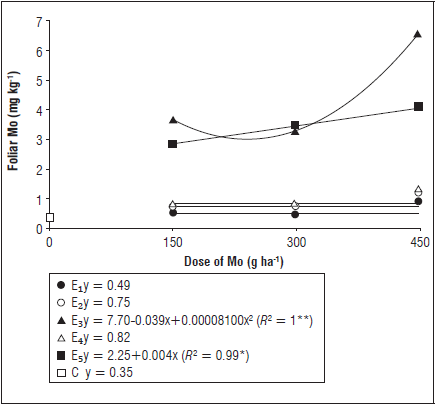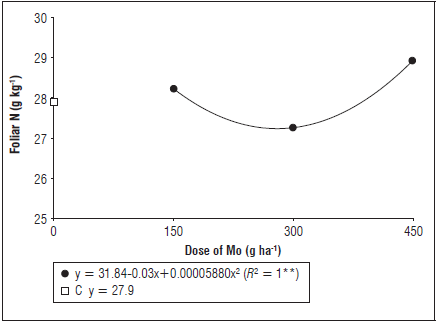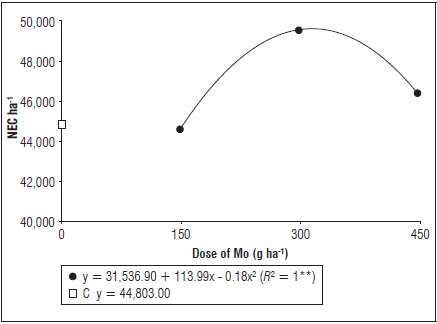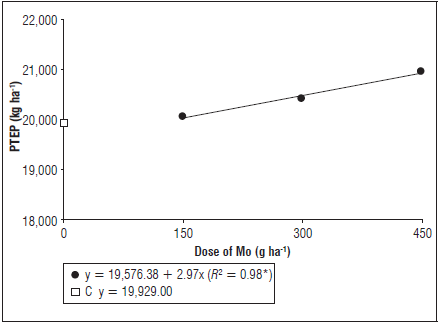INTRODUCTION
In Brazil, sweet corn (Zea mays var. saccharata) is grown in approximately 30,000 ha, with 90% of that area located in the State of Goiás (Luz et al., 2014). In the State of São Paulo, sweet corn is in great demand in the industrial sector (because of the sweet taste of the grains and the effect of different mutant alleles that control the conversion of starch into sugar), especially for the manufacture of canned food (Mendoza-Cortez et al., 2016).
Mineral nutrition and crop fertilization are among the factors that influence high productivity. Although it is necessary in only small amounts (0.1 to 0.2 mg kg-1 of dry matter) (Maynard and Hochmuth, 2007), Mo is a micronutrient of great importance because it is a nitrate reductase enzyme (Hamlin, 2007; Fageria, 2009), indispensable in the metabolism of N and, therefore, having an indirect effect on the growth and productivity of crops.
Most soils contain enough amounts of this micronutrient; however, its absorption is affected under conditions of low temperatures, high N fertility (Hamlin, 2007), high rainfall and, mainly, acidic soils, where it is strongly adsorbed at the surface of iron and aluminum oxides, becoming unavailable to plants (Fageria, 2009).
A deficiency of this micronutrient is more evident during the reproductive phase than in the vegetative phase (Hamlin, 2007). Mo-deficient corn plants are more likely to have premature sprouting of the grains, which is accentuated when there is a greater availability of N in the soil (Tanner, 1978). In addition, there is a reduction in the size of tassels, male flowers and anthers; there is anthesis suppression and delay, decrease in the activity of some enzymes and increase of others, which affect the viability of pollen during development (Agarwala et al., 1979). On the other hand, Mo toxicity in plants is rare, even when there is a high absorption rate of this micronutrient, especially under field conditions (Leite et al., 2007).
Methods to prevent Mo deficiencies include in-band or field-wide applications, foliar applications and seed treatment. According to Hamlin (2007), foliar applications are much more efficient than soil applications, especially in acidic soils or under dry weather conditions.
The small number of studies carried out on Mo applications, via foliar or associated with N applied to the soil, are for conventional corn and corn used for popcorn (Valentini et al., 2005; Teixeira, 2006; Araújo et al., 2010; Pereira, 2010; Santos et al., 2010; Santos et al., 2012; Gaspareto et al., 2014; Caioni, 2015). There is a shortage of current information on sweet corn under Brazilian conditions.
In this context, the objective of the present study was to evaluate the agronomic performance of sweet corn as a function of molybdenum dose, supplied via foliar applications, with different application timings.
MATERIALS AND METHODS
This experiment was conducted in the municipality of Jaboticabal, State of Sao Paulo, Brazil, between August and November of 2015.
The soil in the experimental area was classified as Latossolo Vermelho (EMBRAPA, 2006). Before the installation of the experiment, the soil was sampled at a depth of 0 to 20 cm, and, according to the results of the chemical analysis, the soil had: pH of 5.7; 22 g dm-3 of organic matter; 40 and 11 mg dm-3 of P (resin) and S, respectively; 44; 14; 3.3 and 30 mmolc dm-3 of Ca, Mg, K and H+Al, respectively; and 67% soil base saturation. Liming was not performed because the percentage of saturation by soil bases was higher than recommended for the cultivation of sweet corn (≥60%). Also, according to the granulometric analysis, the soil had 592, 161 and 247 g kg-1 of clay, silt and sand, respectively.
The experiment was installed in a randomized complete block design, in a 3x5+1 factorial scheme, with four replications. The treatments corresponded to three doses of molybdenum (150, 300 and 450 g ha-1) and five application timings (E1: 100% at 15 days after emergence - DDE; E2: 100% at 30 DDE; E3: 100% at 45 DDE; E4: 50% at 15 and 30 DDE and E5: 33.3% at 15, 30 and 45 DDE). The control treatment (C) corresponded to the non-application of molybdenum.
The experimental unit consisted of five rows of plants, 7.5 m long. The variables were evaluated in the plants located in the central five meters of the three central rows of each experimental unit.
The sweet corn 'SVN 9298', from Monsanto, was sown on August 24, 2015, with 0.50 m between rows. After 7 DDE, clearing was done in order to adjust the distance between plants to 0.33 m, which allowed an estimated population of 60,606 plants/ha.
Based on the recommendation of Cantarella et al. (1997), 60 kg ha-1 of P2O5 (simple superphosphate) and 50 kg ha-1 of K2O (potassium chloride) were applied at planting. In coverage, 40 kg ha-1 K2O were applied only once, in stage V4. In the case of N (urea), 170 kg ha-1 were applied, fractionated three times in equal amounts (at 3 DDE; at 20 d after the first application, which coincided with the beginning of the definition of the productive potential, in stage V4; and 20 d after the second application, when the number of rows of grain was defined in the ear, in stage V6).
Ammonium molybdate was used as the source of Mo, via foliar spraying. Tween® adhesive dispersant was used, at 10 mL per 100 L of water. The volumes of the solution (ammonium molybdate plus dispersant) in the foliar applications at 15, 30 and 45 DDE were 270, 400 and 600 L ha-1, respectively.
The evaluated characteristics were: nitrogen content (g kg-1) and molybdenum (mg kg-1) in the diagnostic leaf, total number of ears (ears/ha), number of commercial ears (commercial ears/ha), total ear productivity (kg ha-1), commercial ear productivity (kg ha-1), ear length (cm), ear diameter (cm) and grain productivity (kg ha-1).
The data were subjected to analysis of variance (F-Test), and, when there was a significant effect, regression analysis was performed for the Mo doses and the Tukey test (5%) was used for the Mo application timing, using AgroEstat (Barbosa and Maldonado Junior, 2015).
RESULTS AND DISCUSSION
There was an effect from the interaction of the evaluated factors on the Mo concentration in the sweet corn leaves (Tab. 1). Adjustments were only obtained for Mo concentrations when the application was made at 45 DDE (E3) and when it was fractionated at 15, 30 and 45 DDE (E5) (Fig. 1).
Table 1 F valor for analysis of variance of molybdenum (CMo) and nitrogen (CN) foliar concentrations, total number of ears (NTE), number of commercial ears (NEC), ear length (COM), ear diameter (DIAM), total productivity of ears with husk (PTEP), commercial productivity of ears without husk (PECSP) and grain productivity (PG) of sweet corn 'SVN 9298', as a function of the doses and timing of Mo foliar applications.

NS, * and **: non-significant and significant at 5% and 1% probability levels by F-test, respectively.
C: control treatment, without application of Mo.

Figure 1 Foliar concentration of Mo as a function of doses and timing of Mo foliar applications in sweet corn 'SVN9298' (C = control, without application of Mo).
In the splitting of the factor interactions, it was verified that, in E3, the minimum concentration of foliar Mo (3.0 mg kg-1) was obtained with the dose of 240 g ha-1. However, with the increase in Mo doses, there was an increase in the micronutrient content, reaching a maximum of 6.6 mg kg-1 with the highest Mo dose. In E5, the lowest (2.85 mg kg-1) and highest (4.0 mg kg-1) concentration of foliar Mo was obtained with 150 and 450 g ha-1 of Mo, respectively (Fig. 1).
The highest concentration of Mo in E3 can be attributed to the greater foliar area that the corn plants had between the evaluated periods, according to the observation made by Kraemer et al. (2009), who found a greater foliar absorption of nutrients when plants had a greater foliar area. Also, the fact that the spraying in E3 was done without dose fractioning may have contributed to the improvement of the efficiency of foliar fertilization.
Plants not fertilized with Mo had 0.35 mg kg-1 of Mo, differing from the average content (2 mg kg-1) observed in the plants that received this element via foliar spraying (Tab. 1).
Although the levels of molybdenum in the soil were not determined, the foliar analysis on the diagnostic leaf allowed for a correcting follow-up foliar fertilization with Mo. The foliar levels of Mo estimated in the fertilized and unfertilized plants were above the critical level considered suitable for this crop, which is 0.1 to 0.2 mg kg-1, according to Cantarella et al. (1997).
Despite the divergence in the results of the foliar application of Mo on the foliar concentration of Mo, positive in corn used for grain (Araújo et al., 2010; Caioni, 2015) and popcorn (Teixeira, 2006) and negative in conventional corn (Teixeira, 2006; Pereira, 2010). Bodi et al. (2015), Kovács et al. (2015) and Taiz and Zeiger (2009) highlighted the importance of providing this micronutrient for increasing its concentration in corn because of its role in N metabolism, directly affecting the growth and development of plants.
The effect of Mo doses on the N content was observed, with a quadratic adjustment of this variable (Fig. 2). The N concentrations were within the appropriate range for corn (27 to 35 g kg-1), according to Cantarella et al. (1997).

Figure 2 Foliar concentration of N and control treatment (C) as a function of the Mo foliar application in sweet corn 'SVN 9298'.
The N content in the diagnostic leaf for the nutritional status of sweet corn sprayed with Mo (28.1 g kg-1) was similar to that obtained in the control plants, which did not receive the micronutrient (27.9 g kg-1).
It was verified that the lowest concentration of N (27.2 g kg-1) was obtained with 280.35 g ha-1 of Mo. Starting at this dose, there were increases in the foliar content of N, reaching 29.3 g kg-1 with the highest dose of Mo (450 g ha-1) (Fig. 2). According to various authors, the importance of Mo lies in the role it plays in the assimilation of N since it is a component of the enzyme nitrate reductase, which is responsible for catalyzing the biological reduction of NO3 - to NO2 -, which is subsequently reduced to NH4 + (Hamlin , 2007; Fageria, 2009; Tejada-Jiménez et al., 2013; Kóvacs et al., 2015).
The total number of ears (NTE) was not influenced by the doses, the timing of the foliar applications of Mo, or the interaction of these factors (Tab. 1). Meanwhile, there was a significant difference between the means of the control treatment (58,503 ears/ha) and the factorial treatments (60,191 ears/ha), with an increase of 2.9% in the NTE in the sweet corn. According to Araújo et al. (2010), this variable can be altered when some nutritional imbalance occurs, a fact that was not found in this study, either as the result of a deficiency or excess, or even as the result of foliar concentrations of Mo and N. Therefore, the higher NTE resulted from the higher foliar contents of Mo and N, as a consequence of the molybdenum fertilization (Fig. 1 and 2). Although significant, the difference between the NTE of the fertilized and unfertilized plants with Mo was small (1,688 ears/ha). Ferreira et al. (2001) and Teixeira (2006), evaluating different Mo doses in corn used for popcorn and conventional corn, did not observe the effect of micronutrient applications on NTE. According to these authors, the lack of response to molybdenum fertilization was because the soil had a satisfactory amount of Mo or because the Mo concentration in the seeds was adequate (Weir and Hudson, 1966).
The number of commercial ears (NEC) was influenced by the foliar application of Mo doses (Tab. 1); this variable was adjusted to the quadratic equation (Fig. 3). The increase in Mo doses benefited the NEC, obtaining the maximum value (49,583 commercial ears/ha) with 316 g ha-1 of Mo, approximately 10% higher than the NEC verified in the control treatment, which was 44,803 commercial ears/ha.

Figure 3 Total number of commercial ears (NEC) and control treatment (C) as a function of the Mo foliar applications in sweet corn 'SVN 9298'.
Molybdenum doses, application timing and the interaction between these factors had no significant effect on the length and diameter of the sweet corn ears. However, there were significant differences between the means of the control treatment and the factorial treatments for these two characteristics (Tab. 1), verifying an increase of 5.3% in length (from 17.6 to 18.5 cm) and 7% in ear diameter (4.7 to 5.1 cm). The values obtained for the length and diameter of the ears were higher than that required for commercial sweet corn (>15 cm in length and > 3 cm in diameter) (Albuquerque et al., 2008). The results differed from those of Caioni (2015), who found no effect from foliar applications of Mo on these variables. According to various authors, the length and diameter of corn ears are greatly influenced by genotype and depend less on the environment and fertilization (Fernandes et al., 2005; Ohland et al., 2005; Goes et al., 2012).
There was no significant effect of Mo doses, application timing, or the interaction of these factors on the total production of ears with husk (PTEP), the total production of commercial ears without husk (PECSP) or the grain production (PG) (Tab. 1).
There was adjustment of the increasing linear equation for the PTEP (Fig. 4), obtaining the maximum value (20,942 kg ha-1) with the dose of 450 g ha-1 of Mo, via foliar spraying. Productivity similar to the present study was also recorded by Cardoso et al. (2010) and Luz et al. (2015) in green maize 'HTMV1' (21,374 kg ha-1) and sweet corn 'SWC01' (21,790 kg ha-1), respectively. The effect of molybdenum fertilization on PTEP was probably due to the fact that Mo promoted a better use of absorbed N, as verified by various authors (Valentini et al., 2005; Caioni, 2015; Kovács et al., 2015). Because of the multiple functions that it fulfills in the metabolism of plants (acting mainly in the synthesis of proteins and as a component of chlorophyll), N stimulates growth and development (increasing the green mass index and photosynthetic performance), altering various yield components and positively influencing the productivity of ears and grains (Gaspareto et al., 2014), a fact that was found in this study for the productivity of sweet corn.

Figure 4 Total productivity of ears with husk (PTEP) and control treatment (C) as a function of the Mo foliar applications in sweet corn ‘SVN 9298’.
The productivity of commercial ears without husk (PECSP) was adjusted to the quadratic equation as a function of Mo doses (Fig. 5). With the estimated dose of 311.3 g ha-1 of Mo, applied via foliar spraying, the highest PECSP (13,211 kg ha-1) was obtained, lower than that found by Cruz et al. (2015), who verified a productivity of 9,919 kg ha-1 of PECSP with the hybrid 'GSS 41243' when evaluating different N doses.

Figure 5 Productivity of commercial ears without husk (PECSP) and control treatment (C) as a function of the Mo foliar applications in sweet corn ‘SVN 9298’.
As stated for the PECSP, grain productivity (PG) was adjusted to the quadratic model (Fig. 6). The highest PG (5,055 kg ha-1) was obtained with a dose of 334.4 g ha-1 of Mo, via foliar spraying, with an increase of 8.6% in relation to the control treatment (4,541 kg ha-1). The same positive effect of the foliar Mo applications was observed by Caioni (2015), reaching a productivity of 9,028 kg ha-1 of grains. Araújo et al. (2010) obtained productivity of 4,251 kg ha-1 of grains in corn used for popcorn, with doses of up to 1,600 g ha-1 of Mo. An increase in PG was also noted by Valentini et al. (2005) in conventional corn. The maximum PG, close to that observed in this study, was verified by Pereira et al. (1999) with the application of 111 g ha-1 of foliar Mo. The authors obtained a 6.7% increase in PG in relation to treatments without the application of micronutrients. On the other hand, Silva et al. (2018) did not verify the effect of different doses of Mo (0, 25, 105, 210, 315 and 420 g ha-1) on grain productivity because the Mo concentrations in the soil and in the seed were sufficient to meet the demand of the corn plants.

Figure 6 Grain productivity (PG) and control treatment (C) as a function of the Mo foliar applications in sweet corn 'SVN 9298'.
Positive results for foliar Mo applications on grain productivity in conventional corn were verified by Santos et al. (2010) and Heidarzade et al. (2016). Caioni et al. (2017) observed effects of nitrogen and molybdenum fertilization on the productivity of grains in corn, with increases in productivity as Mo doses increased, concluding that this effect was probably due to the greater accumulation of proteins in grains as a result of the greater availability of N in the soil solution. According to Araújo et al. (2010), the addition of Mo, via foliar spraying, can increase the activity of the enzyme nitrate reductase, which participates directly in the metabolism of N. In addition, N acts on pollen formation and on the reduction of abortion of ovules, consequently affecting grain formation and crop productivity (Carvalho and Nakagawa, 2000).
No toxicity symptoms were observed when the highest Mo dose was applied, indicating that the sweet-corn hybrid 'SVN 9298' can tolerate high doses of this micronutrient without impairing grain productivity. Teixeira (2006), applying different doses of Mo (between 0 to 1600 g ha-1) via foliar spraying, did not observe symptoms of toxicity in corn plants, concluding that this crop has a high response capacity at high doses of this micronutrient. Vieira et al. (2005), evaluating high Mo doses (between 0 and 1440 g ha-1) via foliar spraying in a bean crop, verified that the application of high doses of this micronutrient did not present a toxic effect for the crop. According to some authors, the use of high doses of molybdenum should promote the accumulation of this nutrient in toxic amounts in plants; however, this does not occur because plants, in general, have reasonable tolerance to the excessive accumulation of this micronutrient (Leite et al., 2007).
CONCLUSIONS
Under the conditions of this experiment, the application timing and the molybdenum doses influenced the foliar concentration of the micronutrient in sweet corn 'SVN 9298'.
Independent of the application timing, the molybdenum foliar spraying influenced the concentration of nitrogen and the agronomic performance of sweet corn 'SVN 9298'.
The total number of commercial ears, the highest total productivity of ears with husk, the highest productivity of commercial ears without husk and the higher grain productivity of sweet corn 'SVN 9298' were obtained with 316; 450; 311 and 334 g ha-1 of molybdenum, via foliar spraying, respectively.















